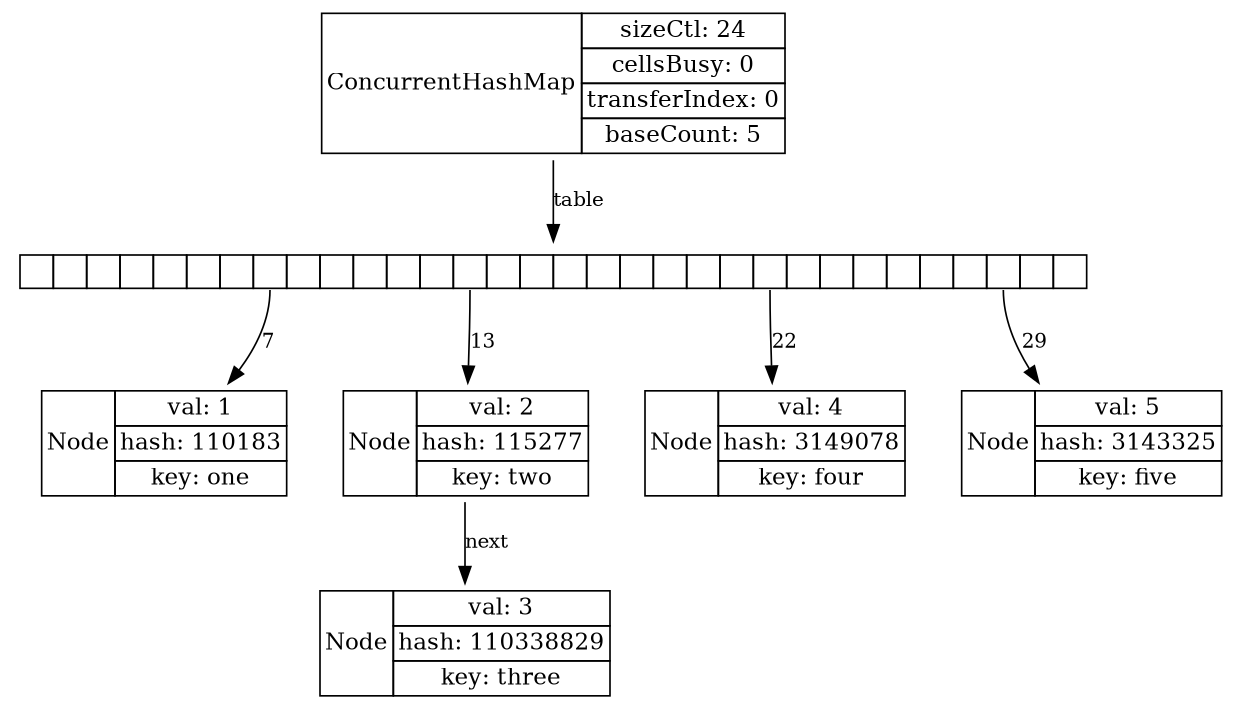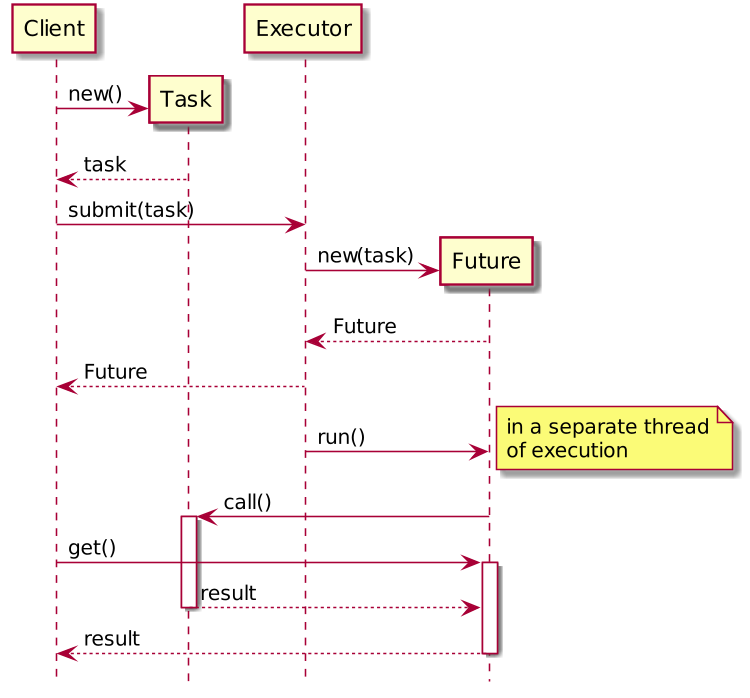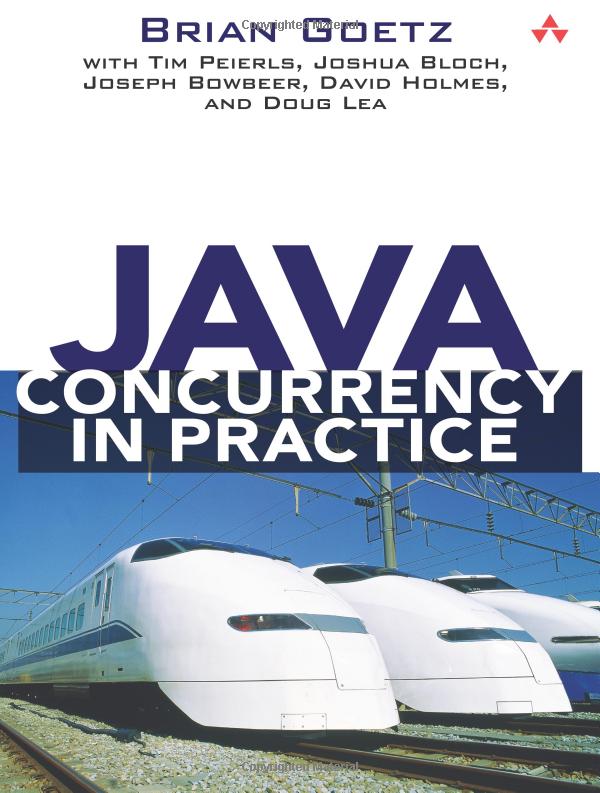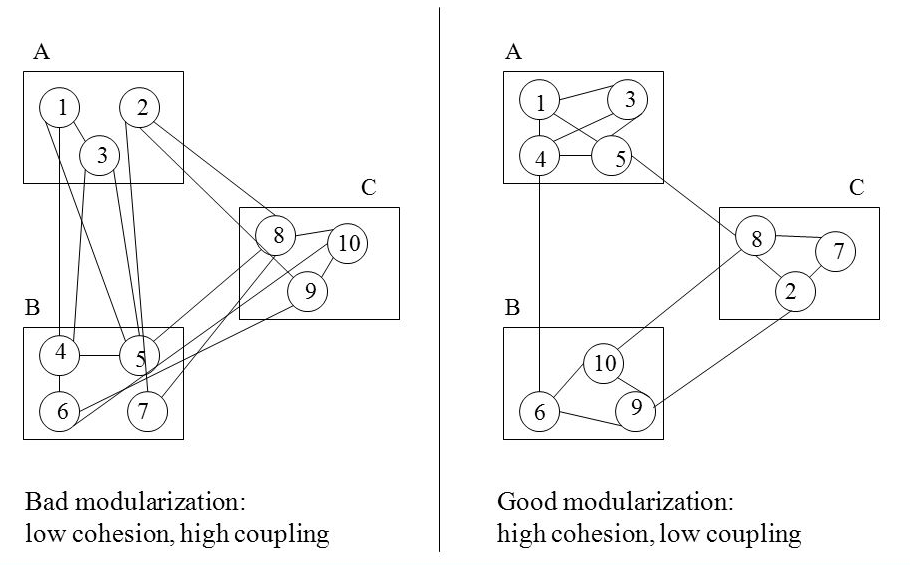getAndSet(newValue) compareAndSet(expect, update)
incrementAndGet() decrementAndGet()
getAndIncrement() getAndDecrement()
getAndAdd(delta) addAndGet(delta)
getAndUpdate(updateFunction)
updateAndGet(updateFunction)
getAndAccumulate(x, accumulatorBiFunction)
accumulateAndGet(x, accumulatorBiFunction)Core Java. Lecture #11
Java Concurrency (ending). Annotations
@inponomarev
Ivan Ponomarev, Synthesized.io/MIPT
Part 3. Thread-safe data structures

Non-blocking algorithms
Locking (via
synchronizedorReentrantLock) solves the issue of coordinating the actions of different threads with a variable.But if many threads compete for the lock (high lock contention), the cost of coordinating the threads becomes significant.
The alternative is non-blocking algorithms that use special atomic machine instructions (compare-and-swap).
In the Java library, classes of atomic variables and thread-safe collections are available, including those implementing non-blocking algorithms.
Atomics
package java.util.concurrent.atomicAtomicBoolean,AtomicInteger,AtomicLong,AtomicReference.AtomicIntegerArray,AtomicLongArray,AtomicReferenceArray.
Can be used as "enhanced volatiles", as the result of calling
set(…)is visible to other threads viaget(…)Support atomic operations.
Atomic operations in atomic variable classes
Thread-safe collections
In earlier versions of Java, it was possible to "make" a collection thread-safe by wrapping it in
Collections.synchronizedXXX(…). This serialized any access to the internal state of the collection. Because of backward compatibility support, doing this is still possible, but not recommended.The price of such a solution is high lock contention.
Version 5 introduces classes specifically designed for thread safety, with fewer locks.
Their use is preferred.
CopyOnWriteArrayList and CopyOnWriteArraySet
class CopyOnWriteArrayList<E> implements List<E>
class CopyOnWriteArraySet<E> extends AbstractSet<E>Array-based data structures.
Recreate themselves from scratch on each modification.
It’s expensive, but all reading iterators are stable.
Good when there are multiple read operations per one write operation.
ConcurrentLinkedQueue/Deque
ConcurrentLinkedQueue<E> extends AbstractQueue<E>
implements Queue<E>
ConcurrentLinkedDeque<E> extends AbstractCollection<E>
implements Deque<E>Based on non-blocking algorithm (CAS operations)
poll()returnsnullif the queue is emptyUnder the hood there are (double) linked lists
ConcurrentLinkedQueue/Deque


Blocking queues: a means of implementing the producer-consumer pattern

May be limited in size (capacity constrained).
The
put()andtake()methods wait until you can put or take an item.PriorityBlockingQueueis not limited by capacity.SynchronousQueuehas no capacity at all, passes elements to processing threads directly.
ConcurrentHashMap
class ConcurrentHashMap<K,V> extends AbstractMap<K,V>
implements ConcurrentMap<K,V>Replaces
HashMapfor multithreaded data access.Not blocked when reading and rarely blocked when writing.
Does not allow the use of
nullas a key or value.Useful methods are atomic:
putIfAbsent(key, value)remove(key, value)replace(key, oldValue, newValue)
ConcurrentHashMap: Java 7-

ConcurrentHashMap: Java 8+

ConcurrentSkipListMap
class ConcurrentSkipListMap<K,V> extends AbstractMap<K,V>
implements ConcurrentNavigableMap<K,V>Replaces
TreeMapfor multithreaded access.Does not allow
nullas a key or a value.Has atomic methods.
ConcurrentSkipListMap: the principle

ConcurrentSkipListMap

ConcurrentSkipListMap

ConcurrentSkipListMap

ConcurrentSkipListMap

ConcurrentSkipListMap

ConcurrentSkipListMap

ConcurrentSkipListMap

ConcurrentSkipListMap

Part 4. Executor Framework

Executor Framework
Thread is an expensive resource, so we want to:
limit the number of our threads so as not to get Out of Memory exception,
reuse existing threads by submitting new tasks after completing the old ones,
if some thread "crashed" - automatically create a new one.
There are Thread Pools in the standard library for all of this, you do not need to implement anything yourself.
No one uses the Thread API directly.
Executor Framework
//Abstraction of a computational task returning a result
public interface Callable<V> {
V call() throws Exception;
}</V>
//Abstraction of the "manager of threads"
public interface ExecutorService {
<T> Future<T> submit(Callable<T> task);
/*... there are many other methods, will discuss later...*/
}Future
//Abstraction of the "in progress" result that you can wait for
//finalization or just cancel
public interface Future<V> {
V get() throws InterruptedException, ExecutionException;
V get(long timeout, TimeUnit unit)
throws InterruptedException, ExecutionException, TimeoutException;
boolean cancel(boolean mayInterruptIfRunning);
boolean isDone();
boolean isCancelled();
}Task, Executor, Future

How do I create an ExecutorService?
public class Executors {
//fixed pool size
public static ExecutorService newFixedThreadPool(int nThreads)
public static ExecutorService newSingleThreadExecutor()
//pool grows as needed, keeps inactive thread for 60 seconds
public static ExecutorService newCachedThreadPool()
//allows you to perform tasks with a delay or periodically
public static
ScheduledExecutorService newScheduledThreadPool(int corePoolSize)
//starts a new virtual Thread for each task
public static ExecutorService newVirtualThreadPerTaskExecutor()
...
}Processing tasks in batches
//Run and wait for everything to finish
//List<Future<T>>, not List<T>, because exceptions are possible
<T>List <Future <T>> invokeAll(
Collection <? extends Callable <T>> tasks)
throws InterruptedException
//Run, return the first successful result
//cancel the rest
<T> T invokeAny(Collection<? extends Callable<T>> tasks)
throws InterruptedException, ExecutionException;Cancellation of tasks and "termination of service"
//cancel a task if it has not already started
future.cancel(false)
//request task interruption (details ahead)
future.cancel(true)
//Prevent new tasks from being accepted
executorService.shutdown();
//Wait until the accepted tasks are completed
if (!service.awaitTermination(10, TimeUnit.SECONDS)){
Abort tasks
service.shutdownNow();
}Interruption of tasks
In early versions of Java, there were (now deprecated) methods for forcibly stopping and suspending/resuming threads, but this turned out to be a bad idea:
there is no guarantee that the thread will not stop in the middle of the atomic operation.
suspension may leave the lock acquired for an indefinite amount of time
All this now is deprecated in favor of cooperative interruption mechanism.
Interrupting threads
ExecutorService.shutdownNow()calls theThread.interrupt()method on threads.the
Thread.isInterrupted()method returns the interrupt status of the thread.JMM Interruption Rule: An external thread call to the
interrupt()method happens before the interrupted thread knows that it has been interrupted.
Cooperative termination mechanism
If the calculations are in a loop, the thread is obliged to periodically check the status of
Thread.currentThread().isInterrupted()and, if the flag is set, write to the log the fact of interruption and exit the method.InterruptedExceptionmay be thrown on waiting methods. What should we do with it?
What should we do with InterruptedException
If circumstances allow, it is best to declare it in
throwsand not to handle it at all.If we cannot change the method’s signature (e. g. we are implementing
runmethod ofRunnableinterface which doesn’t throw checked exceptions) then:
} catch (InterruptedException e) {
//record the fact of interruption to the log...
...
//restore the interrupted status
Thread.currentThread().interrupt();
//exit the interrupted method
return;
}You should never silently "swallow" an
InterruptedException!It is recommended to log the fact of interruption to facilitate debugging.
CompletableFuture
Introduced in Java 8, extending
Future.Allow you to explicitly set the result (hence
Completable) and assemble a chain of asynchronous calculations.Can be used as follows:
CompletableFuture<Integer> f = new CompletableFuture<>();
executor.execute(() -> {
int n = workHard(arg);
f.complete(n); });
executor.execute(() -> {
int n = workSmart(arg);
f.complete(n); });
executor.execute(() -> {
Throwable t = ...;
f.completeExceptionally(t); });CompletableFuture composition with action
Method | Parameter | Description |
| T→U | Apply a function to the result. |
| T→void | Like |
| T→CompletableFuture<U> | Invoke the function on the result and execute the returned future. |
| (T, Throwable) → U | Process the result or error and yield a new result. |
| (T, Throwable) → void | Like |
CompletableFuture composition with action
Method | Parameter | Description |
| T, long, TimeUnit | Yield the given value as the result in case of timeout (Java 9+) |
| long, TimeUnit | Throw `TimeoutException ` in case of timeout (Java 9+) |
| Runnable | Execute the |
Composition of several CompletableFutures
Method | Parameter | Description |
| ComletableFuture<U>, | Execute both and combine the results with the given function. |
| ComletableFuture<U>, | Like |
| CompletableFuture<?>, | Execute the runnable after both complete. |
Composition of several CompletableFutures
Method | Parameter | Description |
| CompletableFuture<T>, | When a result is available from one or the other, pass it to the given function. |
| CompletableFuture<T>, | Like |
| CompletableFuture<?>, | Execute the runnable after one or the other completes. |
| CompletableFuture<?>… | Complete with |
| CompletableFuture<?>… | Complete after any of the given futures completes, with the same result cast to |
If that didn’t seem enough…
Each of these methods has a variant with the postfix
Async(for example,thenApplyAsync) that allows you to perform an additional action in another thread of the specified Executor.
We just scratched the surface
 |
|
Code Review Checklist
Roman Leventov: Code Review Checklist: Java Concurrency
About 100 points to check the concurrency code for common errors
Acknowledgements
These people gave their feedback and helped to improve the material of this lecture:
@2caco3 @asm0dey @dolzhenko @DrEdwardHyde
@dyer_the @krems5 @LordOfBoredom
@miha_x64 @vaddyacom @vdimir
(all errors and inaccuracies are mine)
Sometimes you feel the smell while reading the code…
import org.json.JSONObject;
class NaivePersonSerializer {
String toJSON(Person person) {
JSONObject result = new JSONObject();
result.put("firstName", person.getFirstName());
result.put("lastName", person.getLastName());
result.put("birthDate",
person.getBirthDate()
.format(DateTimeFormatter.ISO_LOCAL_DATE));
result.put(...)
result.put(...)
//20 more fields
result.put(...)
return result.toString();
}
}There is a feeling that something is wrong…
public class NaiveController {
private final Service service;
public void executeCommand(String command) {
switch (command) {
case "foo":
service.foo(); break;
case "bar":
service.bar(); break;
case ...
//15 more branches...
case "help":
default:
service.help(); break;
}
}
}Coupling & Cohesion
Coupling: the degree of interdependence between software modules; a measure of how closely connected two routines or modules are; the strength of the relationships between modules.
Cohesion refers to the degree to which the elements inside a module belong together.
Low coupling often correlates with high cohesion, and vice versa.
Coupling vs. Cohesion

Questions
Why coupling is high and cohesion is low in the above examples?
What danger does it impose on the project?
How would we like to solve this problem?
//Mark what we want to serialize, do not serialize by default.
//(Option: mark what we do not want to serialize, serialize by default)
public class Person {
@Published
private final String firstName;
@Published
private final String lastName;
@Published
private final LocalDate birthDate;
//... as many other fields as you like
}
//As an option...
JsonSerializer<Person> ser = new JsonSerializer<>(Person.class);
JSONObject json = ser.serialize(p);Controller
public class Controller {
private final Service service;
@Command("foo")
void doSomething() { service.foo(); }
@Command("bar")
void bar() { service.bar(); }
//15 more commands
@Command() //default one
void help() { service.help(); }
}
new CommandDispatcher(new Controller(srv)).executeCommand("foo");Annotations
Annotation is a way of marking up Java code by adding meta-information to various elements of a Java program.
They work approximately like modifiers (
public,static), but there is a mechanism for creating your own annotations.Can be processed at three stages:
at the stage of code generation before compilation (annotation processing, Language Model API),
at the stage of instrumentation of bytecode (Instrumentation API),
at the stage of code execution (via Reflection API).
Annotation definition syntax
modifiers @interface AnnotationName {
type elementName();
...
type elementName default value;
}Example
public @interface BugReport {
String assignedTo() default "";
int severity();
}Annotation Interfaces
Just as
enumclasses are a special kind of class, annotation interfaces are a special kind of interface.Inherited from
java.lang.annotation.Annotation.Cannot be extended by inheritance, cannot be parameterized through generics.
Methods cannot have parameters.
Valid return types of annotation methods (JLS 9.6.1)
Primitives (
int,short,long,byte,char,double,float,boolean),enums,
String,Class(with a possible parameter restriction likeClass<? extends MyClass>),other annotations,
arrays of the above (but not arrays of arrays).
Annotation Interface Definition Example
public @interface BugReport {
//nested types are valid!
enum Status {UNCONFIRMED, CONFIRMED, FIXED, NOTABUG}
boolean showStopper() default false;
String assignedTo() default "";
//metaclass, to be explained later
Class<?> testCase() default Void.class;
Status status() default Status.UNCONFIRMED;
//Annotation type. We use a special syntax to construct an instance ,
//to be explained later
Reference ref() default @Reference(id = "");
String[] reportedBy();
}Use of annotations
@AnnotationName(elementName1=value1, elementName2=value2,...) @AnnotationName(singleValue) @AnnotationName //no values, no parens
Use of annotations
@BugReport(assignedTo="Harry", severity=10)
//order doesn't matter
@BugReport(severity=10, assignedTo="Harry")
//if default values are set, you can skip the parameters
@BugReport(severity=10)
//if there are no parameters or all of them have default,
//then brackets can be omitted
@BugReport
//if there is no default value for the parameter, it must be defined
//(otherwise a compilation error).Single-value annotations
public @interface ActionListenerFor {
String value();
int priority() default 0;
}
//use
@ActionListenerFor("yellowButton")
//which is equivalent to
@ActionListenerFor(value = "yellowButton")
//at the same time:
@ActionListenerFor(value = "yellowButton", priority = 1)Arrays and other annotations
//Arrays are specified in curly braces
@BugReport(..., reportedBy = {"Harry", "Carl"})
//Same as {"Harry"}
@BugReport(..., reportedBy = "Harry")
//Constructing nested annotations
@BugReport(..., ref = @Reference(id = "12345"))
//... As you can see, using the allowed types,
//you can specify an arbitrarily complex data structureThe annotation value cannot be set to null. null will not be allowed even for default values. |